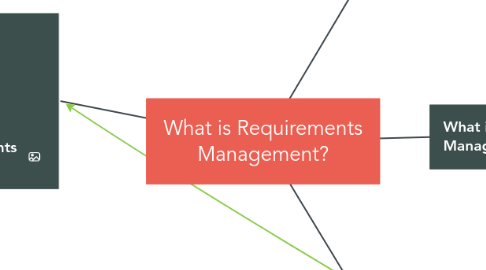
1. Contents of the Requirements Management Plan
1.1. Project overview
1.1.1. Briefly outlines the purpose of the project
1.2. Analyzing and gathering requirements
1.2.1. Outlines the process involved in identifying and documenting the requirements using multiple elicitation techniques.
1.2.2. Means
1.2.2.1. Interviews
1.2.2.2. Questionnaire
1.2.2.3. User observation
1.2.2.4. Workshop
1.2.2.5. Brainstorming
1.2.2.6. Role playing
1.2.2.7. Use cases & scenarios
1.2.2.8. Prototyping
1.3. Roles & responsibilities: Defining who will perform various activities in the project
1.3.1. Project manager
1.3.1.1. Develop a project plan
1.3.1.2. Manage deliverable according to the plan
1.3.1.3. Recruit project staff
1.3.1.4. Lead and manage the project team
1.3.1.5. Determine the methodology for the project
1.3.1.6. Establish a project schedule and determine each phase
1.3.1.7. Assign tasks to project team members
1.3.1.8. Provide regular updates to upper management
1.3.2. Project team member
1.3.2.1. In-house staff or external consultants
1.3.2.2. Contributing to overall project objectives
1.3.2.3. Completing individual deliverable
1.3.2.4. Providing expertise
1.3.2.5. Working with users to establish and meet business needs
1.3.2.6. Documenting the process
1.3.3. Project sponsor
1.3.3.1. Make key business decisions for the project
1.3.3.2. Approve the project budget
1.3.3.3. Ensure availability of resources
1.3.3.4. Communicate the project’s goals throughout the organization
1.3.4. Executive sponsor
1.3.4.1. Carry ultimate responsibility for the project
1.3.4.2. Approve all changes to the project scope
1.3.4.3. Provide additional funds for scope changes
1.3.4.4. Approve project deliverable
1.3.5. Business analyst
1.3.5.1. Assist in defining the project
1.3.5.2. Gather requirements from business units or users
1.3.5.3. Document technical and business requirements
1.3.5.4. Verify that project deliverable meet the requirements
1.3.5.5. Test solutions to validate objectives
1.4. Tools
1.4.1. Documentation tools
1.4.2. Management tools
1.4.3. Requirement tracking tools
1.5. Requirement traceability
1.5.1. Documenting the life of project requirements, from origin to implementation to change
1.5.2. Types
1.5.2.1. Forward Traceability
1.5.2.1.1. Association between functional and system requirements
1.5.2.1.2. Steps
1.5.2.2. Backwards / Reverse Traceability
1.5.2.2.1. Source of all requirements define in the System Requirements Specifications (SRS)
1.6. Change control
1.6.1. Record the change
1.6.2. Analyze
1.6.3. Build and Test
1.6.4. Implement
2. What is a Requirement in Project Management?
2.1. Conditions or tasks to be completed for the success of the project.
2.2. Types of requirements
2.2.1. Functional / Business
2.2.1.1. Product capabilities
2.2.2. Non-Functional
2.2.2.1. Usability
2.2.2.2. Performance
2.2.2.3. Reliability
2.2.2.4. Security
3. What is Requirements Management?
3.1. Requirements management is the process of identifying and managing needs of stakeholders in a system.
3.2. The process involves:
3.2.1. Gathering requirements
3.2.2. Evaluating requirements
3.2.3. Prioritizing requirements
3.2.4. Finalizing requirements
3.3. Goal
3.3.1. To ensure smooth communication with relevant stakeholders throughout the project.
4. Scope Management Plan vs. Requirements Management Plan
4.1. Key elements of scope management plan
4.1.1. Prepare a good project scope statement
4.1.2. People to involve for a work breakdown structure
4.1.3. Handling changes to WBS
4.1.4. Acceptance criteria
4.2. Key elements of requirement management plan
4.2.1. Requirements traceability and implementation tracking
4.2.2. Prioritizing the requirements
4.2.3. Measurements to ensure requirements are realized
4.2.4. Change handling
